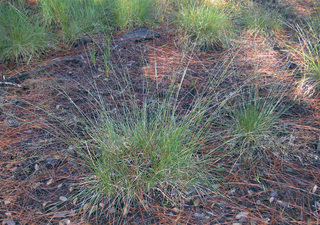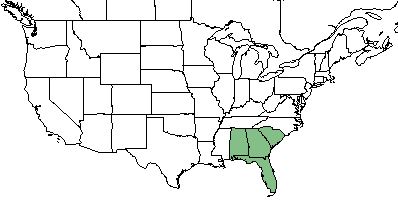Difference between revisions of "Sporobolus floridanus"
Juliec4335 (talk | contribs) |
|||
| Line 30: | Line 30: | ||
===Habitat=== <!--Natural communities, human disturbed habitats, topography, hydrology, soils, light, fire regime requirements for removal of competition, etc.--> | ===Habitat=== <!--Natural communities, human disturbed habitats, topography, hydrology, soils, light, fire regime requirements for removal of competition, etc.--> | ||
''S. floridanus'' is found in wet savannas,<ref name="Weakley 2015"/>, seepage bogs, and titi/cypress swamps and is abundant in wet pine savannas.<ref name="Drewa et al 2002">Drewa P. B., Platt W. J., and Moser E. B. (2002). Community structure along elevation gradients in headwater regions of longleaf pine savannas. Plant Ecology 160(1):61-78.</ref> In north Florida mesic flatwoods ''S. floridanus'' occurred in 53% of plots with a mean coverage of 0.0613 m<sup>-2</sup> and was the sole herbaceous indicator species this community type.<ref name="Carr et al 2010">Carr S. C., Robertson K. M., and Peet R. K. (2010). A vegetation classification of fire-dependent pinelands of Florida. Castanea 75(2):153-189.</ref> | ''S. floridanus'' is found in wet savannas,<ref name="Weakley 2015"/>, seepage bogs, and titi/cypress swamps and is abundant in wet pine savannas.<ref name="Drewa et al 2002">Drewa P. B., Platt W. J., and Moser E. B. (2002). Community structure along elevation gradients in headwater regions of longleaf pine savannas. Plant Ecology 160(1):61-78.</ref> In north Florida mesic flatwoods ''S. floridanus'' occurred in 53% of plots with a mean coverage of 0.0613 m<sup>-2</sup> and was the sole herbaceous indicator species this community type.<ref name="Carr et al 2010">Carr S. C., Robertson K. M., and Peet R. K. (2010). A vegetation classification of fire-dependent pinelands of Florida. Castanea 75(2):153-189.</ref> | ||
| + | |||
| + | ''Sporobolus floridanus'' is an indicator species for the North Florida Mesic Flatwoods community type as described in Carr et al. (2010).<ref>Carr, S.C., K.M. Robertson, and R.K. Peet. 2010. A vegetation classification of fire-dependent pinelands of Florida. Castanea 75:153-189.</ref> | ||
===Phenology=== <!--Timing off flowering, fruiting, seed dispersal, and environmental triggers. Cite PanFlora website if appropriate: http://www.gilnelson.com/PanFlora/ --> | ===Phenology=== <!--Timing off flowering, fruiting, seed dispersal, and environmental triggers. Cite PanFlora website if appropriate: http://www.gilnelson.com/PanFlora/ --> | ||
Revision as of 15:36, 23 July 2020
| Sporobolus floridanus | |
|---|---|

| |
| Photo by Bobby Hattaway hosted at Discoverlife.org | |
| Scientific classification | |
| Kingdom: | Plantae |
| Division: | Magnoliophyta - Flowering plants |
| Class: | Liliopsida - Moncots |
| Order: | Poales |
| Family: | Poaceae |
| Genus: | Sporobolus |
| Species: | S. floridanus |
| Binomial name | |
| Sporobolus floridanus Chapm. | |

| |
| Natural range of Sporobolus floridanus from USDA NRCS Plants Database. | |
Common Name(s): Florida dropseed[1]
Contents
Taxonomic Notes
Description
‘’Sporobolus floridanus’’ is a monoecious perennial graminoid. [2]
Distribution
It can be found in South Carolina, Georgia, Florida, and Alabama.[1][2]
Ecology
Habitat
S. floridanus is found in wet savannas,[1], seepage bogs, and titi/cypress swamps and is abundant in wet pine savannas.[3] In north Florida mesic flatwoods S. floridanus occurred in 53% of plots with a mean coverage of 0.0613 m-2 and was the sole herbaceous indicator species this community type.[4]
Sporobolus floridanus is an indicator species for the North Florida Mesic Flatwoods community type as described in Carr et al. (2010).[5]
Phenology
S. floridanus has been observed to flower from June through September.[1][6]
Seed dispersal
This species is thought to be dispersed by gravity. [7]
Fire ecology
In Georgia, the percent cover of S. floridanus increased from 0.4% after one growing season following a burn to 1.0% after 8 growing seasons.[8]
Conservation and Management
Cultivation and restoration
Photo Gallery
References and notes
- ↑ 1.0 1.1 1.2 1.3 Weakley A. S.(2015). Flora of the Southern and Mid-Atlantic States. Chapel Hill, NC: University of North Carolina Herbarium.
- ↑ 2.0 2.1 USDA, NRCS. (2016). The PLANTS Database (http://plants.usda.gov, 10 January 2018). National Plant Data Team, Greensboro, NC 27401-4901 USA.
- ↑ Drewa P. B., Platt W. J., and Moser E. B. (2002). Community structure along elevation gradients in headwater regions of longleaf pine savannas. Plant Ecology 160(1):61-78.
- ↑ Carr S. C., Robertson K. M., and Peet R. K. (2010). A vegetation classification of fire-dependent pinelands of Florida. Castanea 75(2):153-189.
- ↑ Carr, S.C., K.M. Robertson, and R.K. Peet. 2010. A vegetation classification of fire-dependent pinelands of Florida. Castanea 75:153-189.
- ↑ Nelson, G. PanFlora: Plant data for the eastern United States with emphasis on the Southeastern Coastal Plains, Florida, and the Florida Panhandle. www.gilnelson.com/PanFlora/ Accessed: 10 JAN 2018
- ↑ Kirkman, L. Katherine. Unpublished database of seed dispersal mode of plants found in Coastal Plain longleaf pine-grasslands of the Jones Ecological Research Center, Georgia.
- ↑ Lemon P. C. (1949). Successional responses of herbs in the longleaf-slash pine forest after fire. Ecology 30(2):135-145.